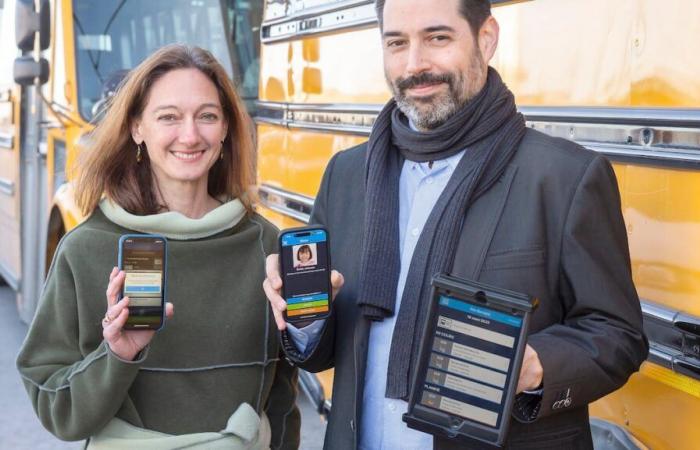
Do you really know what’s going on in your child’s yellow bus? Vulgar or aggressive drivers, turbulent students out of control, lost children. The newspaper peeled hundreds of complaints related to school transport.
When embarking and disembarking from the yellow bus, the student scans his card. How is it that this simple solution created by a company from here, which would solve most of the lost children’s problems, is used by so few schools?
“Parents who order food will have more information on the course of their pizza than they have on their child [dans l’autobus scolaire]», Ironizes Frédéric Laurendeau, president of the Montreal company Mphase.
The newspaper Published during the last days a large file on the problems experienced on board school buses, including the many cases of lost children after being disembarked in the wrong place.
However, a simple technological solution exists: the Mtransport application, created by Mphase, a communication, geolocation and presence system system.
Code QR
In each vehicle that uses this system, an electronic tablet allows you to follow the route, including each stop with the list of children down there.
When a student takes and arrives from the bus, he scans his personal card, which has a QR code.
If he tries to get into the bad vehicle or go down to the wrong stop, the system warns the driver. If the child is too young to disembark without a parent welcomes him, the system emits a particular sound.
During this time, parents can follow the evolution of the bus in real time, namely if it is approaching, if it is a little delay or a lot of delay.
“There are drivers who could no longer imagine happening,” says Laurendeau.
In gender tools, Mtransport is the most widespread in Canada, he said.
In Quebec, only 11 service centers or school boards (CSS) use it, one of the 70 minority in the province.
Budgetary constraints
Why so little? The list of possible reasons is long, such as the resistance of certain transport companies and bureaucratic rules which prevent subjecting to certain tenders, lists Mr. Laurendeau.
For example, at the CSS des Portes-de-l’Otaouais, we would like to set up a system of GPS with tablets, but the project had to be put on pause.
“Our constraint currently is the budgets,” says Jean-Sébastien Roy, deputy director of the school organization. With the restrictions imposed by the Ministry of Education, “it’s not the right time,” he explains.
Of course, drivers have gone from this kind of technology for decades.
But the industry did not know the same personnel rolling problems, one of the factors behind the many incidents listed by the Journal.
Some examples of complaints on lost children
▪ “I contacted the police,” said a parent who was unable to know where his child was. The vehicle finally arrived at home with 1 hour 30 minutes late. It was impossible to obtain information from the school or the carrier. –CSS des Mille-Îles, Laurentides
▪ In November 2022, a replacement driver landed a girl 1.6 km from her usual stop, even if she told him that it was not her stop. Fortunately, a 12 or 13 -year -old boy, worried about her, went down to accompany him while he lived 6 km away. –CSS des Draveurs, Outaouais
▪ “It’s not up to children to guide the driver!” A parent is indignant in a complaint in October 2024. After a bus breakdown, another driver came to get the children, but he did not know the journey at all, so he had to trust the indications of young people. “Several were crying on the bus.” –CSS de la Pointe-de-l’île, Montreal
See other examples ❯
Longue students and forgotten kindergartens because they fell asleep in the bus, it is a thing of the past in a school service center (CSS) which opted for the Mtransport turn.
“Cases of students landed in the wrong place, we avoid it a lot,” says Marie-Claude Gaudreault, director of the school organization at the CSS de la Rivière-du-Nord, in the Laurentians.
The classic case: a kindergarten student who falls asleep and then wakes up too late. If he is confused and tries to go down to the wrong place, a red light comes on.
An example of a card with QR code that the student scans when embarking and disembarking from the bus.
Courtesy (CSS de la Rivière-du-Nord)
This CSS is one of the most advanced in the location. Since September 2024, all of their students transported have their card with QR code.
60 ¢ per student
The system costs them $ 12,000 to $ 20,000 per year. This comes back to them at an annual cost of some 60 ¢ per student transported, estimates René Brisson, managing director of the CSS.
Previously, the communication chain was heavy.
For example, a parent who was looking for his child had to communicate with the CSS, who joined the transport company, who contacted the driver, who returned to his carrier, who then started again with the CSS to inform the parent, explains Mme Gaudreault.
Now the CSS holds the information about its entire fleet and the students on a real time.
This system was particularly useful when a bus has bogged down in a street, illustrates Mme Gaudreault. “We were quickly able to join the parents, but only those concerned”, instead of sending an email to everyone.
Ghost places
The main problem that the CSS faces is that of young people in primary school who forget or lose their card. They can still get on board, but officials must constantly reprint cards.
“We are talking about 1% of students. It is a thin problematic for all advantages ”, nuances Mr. Brisson.
The next step for them is to use the application to tackle “ghost places”, that is to say children registered in school transport, but who do not use it, which leads to an “astronomical cost”, explains Mr. Brisson.
Note: The newspaper could not obtain the contents of the complaints received at the CSS of the River-du-Nord when it tour of requests for access to information.
Do you have a good or bad school transport adventure?
Write me at the address







